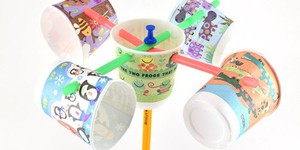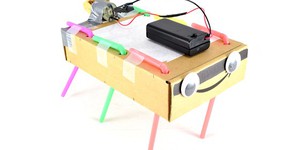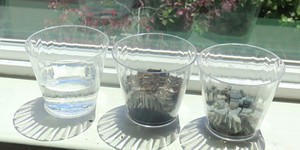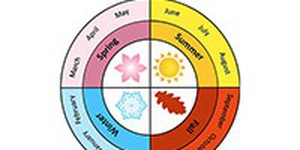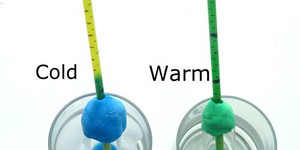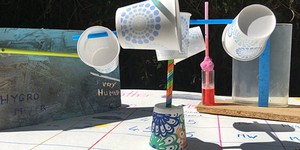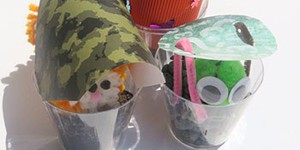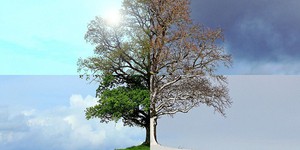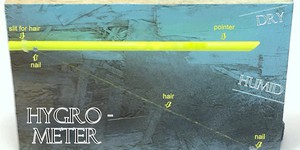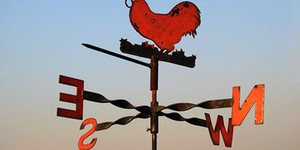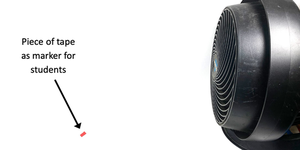Weather & Atmosphere Lesson Plans (10 results)
Everybody talks about the weather, but nobody does anything about it.
- Charles Dudley Warner
Weather and atmospheric science offer lots of opportunities for interesting explorations. It's a satisfyingly complex area, with lots of online resources so you can make your project as easy or as advanced as you want. And when you're done, you'll have a science fair project everyone can talk about.
|
Select a resource
Sort by
|
Lesson Plan
Grade: 3rd
13 reviews
Help the budding meteorologists in your classroom learn how to measure wind speed by building their own anemometers (wind speed meters) with paper cups and straws. Then do a simple experiment in which students change the "wind" speed using a fan and measure how fast their anemometer spins.
Read more
NGSS Performance Expectations:
Featured
Lesson Plan
Grade: 6th-8th
7 reviews
Junkbots are easy-to-build robots that you can make using a simple circuit and some recyclable materials. In this lesson, your students will learn about engineering design as they compete to build the fastest robot. No previous robotics experience is required!
Read more
NGSS Performance Expectations:
Lesson Plan
Grade: Kindergarten
3 reviews
Kindergarten students associate the sun with light and warmth. This lesson helps them expand this knowledge by getting their hands dirty! They will fill cups with soil, water and rocks and place them in the sun and shade for a while. By finding out how they can tell where a cup has been stored, they will learn how the sun affects Earth's surface.
In a follow-up lesson, Create Shade to Protect from the Sun, students figure out how to protect a territory from getting too hot in the sun.
Read more
NGSS Performance Expectations:
Lesson Plan
Grade: Kindergarten
In this lesson, students will create weather report cards of their birthday seasons and analyze them to identify differences and similarities between them. Based on their observations, they will explain how weather conditions change between seasons and discuss how we adapt to seasonal changes.
Read more
NGSS Performance Expectations:
Lesson Plan
Grade: 3rd
3 reviews
Students experience the weather every day: they feel cold spring mornings and warm summer afternoons. This hands-on lesson helps them quantify how hot or cold it is by using a thermometer they will make themselves! Based on their gathered data and observations, students can infer patterns about how temperature varies by location and time.
Read more
NGSS Performance Expectations:
Lesson Plan
Grade: 3rd
How do scientists know what the weather will be like in the future? In this fun weather lesson, students set up a weather station and collect data such as sky coverage, temperature, and rainfall. As they identify connections in their data, students will realize that these connections can help forecast what the weather will be like in the short-term future. The lesson culminates in students making and presenting a weather forecast for their fellow students.
Read more
NGSS Performance Expectations:
New
Lesson Plan
Grade: 6th-12th
Create a two-part system for filtering greywater. Teams will focus on communication and systems engineering as they build separate components to filter solid and liquid waste and then combine them into one device.
Learning Objectives
Students will:
Consider the potential effects of drought and how greywater could be part of the solution.
Design a system for filtering out solid waste or liquid waste.
Consider effective communication strategies with their team.
Collaborate on their design…
Read more
Lesson Plan
Grade: Kindergarten
3 reviews
Students will enter this lesson knowing that materials get warm in the sun. In this fun follow-up activity, your students will get creative with craft materials. They will figure out how to protect an "animal" and its territory from getting too hot in the sun. What will they build to keep their animals cool?
This lesson connects effortlessly with the How Sunlight Warms the Earth lesson.
Read more
NGSS Performance Expectations:
Lesson Plan
Grade: Kindergarten
1 review
In this lesson, students will investigate seasonal patterns by matching various pictures to the different seasons. In small groups, students will analyze the pictures for clues to a specific season, describe what they observe, and explain what evidence they have found in each picture to identify the season. By comparing the images, students will be able to recognize patterns and identify seasonal changes over time.
Read more
NGSS Performance Expectations:
Lesson Plan
Grade: 3rd
What do a crazy hair day, a wooden door stuck in its frame, and the weather have in common? Humidity! In this fun hands-on weather lesson students explore surprising information about human hair, the air around them, and the weather by building a hygrometer from a strand of hair, a straw, a wooden panel, and two nails. A great way to make humidity visible!
Read more
NGSS Performance Expectations:
Lesson Plan
Grade: Kindergarten-5th
Students learn the difference between global, prevailing, and local winds. They make wind vanes out of paper, straws, and soda bottles and use them to measure wind direction over time. They analyze their data to draw conclusions about the local prevailing winds.Engineering Connection
Understanding the patterns and behavior of global and localized winds enables engineers to design technologies that protect us from wind and exploit the energy of wind. Engineers design…
Read more
NGSS Performance Expectations:
Video Lesson
Grade: 3rd
Wind is a part of our everyday weather. Its strength can range from a soft breeze to a violent storm. In this lesson, students learn how to measure wind speed by building anemometers (wind speed meters) from paper cups and straws and experimenting with them.
Read more
NGSS Performance Expectations:
|
Explore Our Science Videos
Build a Submarine -STEM activity
4 Easy Robot Science Projects for Kids
Build a K'Nex® Differential


